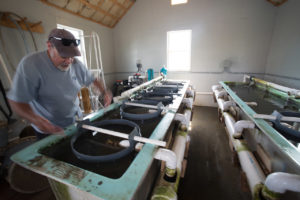A group of students from the School of Journalism spent their semester learning about and researching water in our very own city of Boston. They completed six individual projects, with come together to form The City of Water, which discusses everything from the issues with water infrastructure and who it hurts, to marine life and how it is effected by pollution, to the Boston Harbor’s history, hidden below the surface.
Small, Dangerous, and Everywhere
Students Trea Lavery, Anisha Samant, Max Schochet, and Naomi Silver have been researching microplastics and their prevalence in the water supply. Caused by pollution in the water, microplastics come in a range of sizes that sit in the ocean. However, microplastics are also found in the water we use for drinking, bathing, and many other places. Though it has been known for years that microplastics are harmful to marine life, scientists are just beginning to study how they effect human life and health.
 Microplastics.
Microplastics.
Underwater, Overflowing with History
Students Mark Adolph, Phil Laurent, Cassandra Lobe, Xoee Margolis, and Yael Schulkes have been studying the intersection of archaeology and diving, with both exploring the hidden world within the Boston Harbor. The Harbor’s history dates back to the 1800’s, and now plates, bowls, and ceramics from those days still live in the Harbor, waiting to be discovered.
 A view below the Boston Harbor.
A view below the Boston Harbor.
Students Emma Samek, Anh Mai Srisuk, Jake Stout, and Camila Verdes took a look at Salem State Professor Ted Maney’s innovative new method of raising mussels: offshore farming. This change in mussel farming protects local species and prevents disease. They were able to capture the way his mussels go from his farm to your table.
 Salem State Professor Ted Maney works in the Cat Cove Marine Lab, one of only three aquaculture centers in Massachusetts, specializing in shellfish. As the first step, mussels are grown in the lab’s hatchery, later to be put on lines off-shore once they grow large enough.“Before I retire I at least want to get us on the way to making it commercially viable,” Maney says.
Salem State Professor Ted Maney works in the Cat Cove Marine Lab, one of only three aquaculture centers in Massachusetts, specializing in shellfish. As the first step, mussels are grown in the lab’s hatchery, later to be put on lines off-shore once they grow large enough.“Before I retire I at least want to get us on the way to making it commercially viable,” Maney says.  Maney assembles a hydrophone which is used to listen to whale migrations. This tool helps monitor activity around the farm to make sure that no whales become entangled in the mussel lines. Additionally, the lines used are of the “break away” type, so no whales get harmed.
Maney assembles a hydrophone which is used to listen to whale migrations. This tool helps monitor activity around the farm to make sure that no whales become entangled in the mussel lines. Additionally, the lines used are of the “break away” type, so no whales get harmed.
Students Hyae In park, Alex Poniatowski, Meryl Prendergast, and Calli Remillard were able to speak to members of Boston’s fishing community about the changes they have been seeing in the Seaport and the fishing market over the last three decades. Their photographs capture the life of the Seaport as well as the people whose lives are intertwined with the Seaport.
 A group of fishermen chatting after their work is done. The community of fishermen is strong as they unite in their common struggles.
A group of fishermen chatting after their work is done. The community of fishermen is strong as they unite in their common struggles.
Inequality Starts at the Water Tap
Students Thomas Herron, Madelaine Millar, Anna Sorokina, and Owen Soule tackled the issue of lead pipes throughout Boston. Due to the age of many buildings in the city, lead pipes pose a significant threat to the health of families, an issue that disproportionately affects low-income and minority neighborhoods and their residents. They share the story of Mr. David Rodriguez, who suffered lead poisoning in his youth, and what exactly are the short- and long-term effects of lead poisoning, and providing info-graphics about lead poisoning and its history current day statistics.

Boston’s seaport for how much longer?
Students Camilla Mayol, Emily Newell, Laura Rodriguez, Gabriella Scarpa explored how rising climates are going to affect Boston’s Seaport, with the prediction that it will eventually be overtaken with flooding. They spoke with Richard McGuinness, deputy director of the Boston Redevelopment Authority, who hopes to help mitigate the damage done by climate change.
By

Journalism Students

